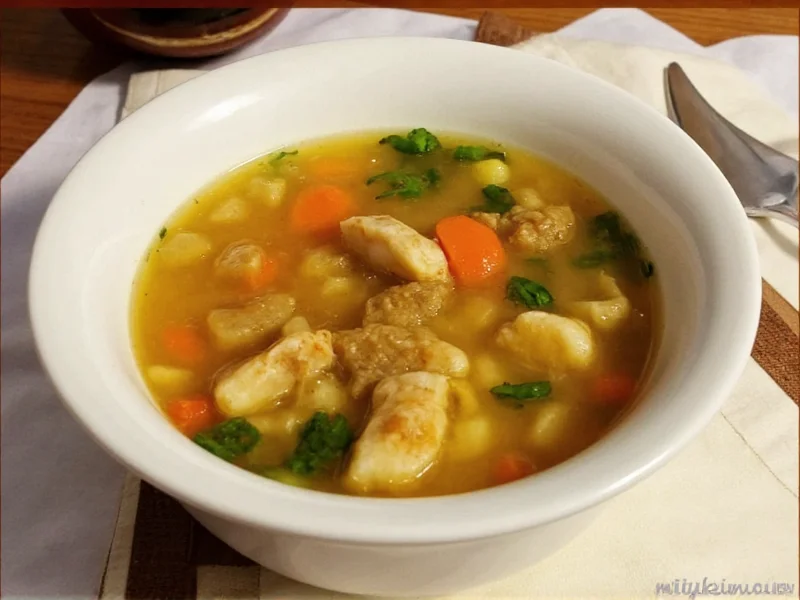A well-crafted fish soup balances delicate seafood flavors with aromatic vegetables and just the right cooking time to prevent fish from becoming tough. This guide provides a foundational recipe that works for weeknight dinners yet has enough depth for special occasions. The secret to exceptional fish soup lies in building layers of flavor while respecting the delicate nature of seafood.
The Science Behind Perfect Fish Soup
Fish soup differs from chowders or bisques because it maintains a light, brothy consistency that showcases the seafood. The Maillard reaction—browning vegetables before adding liquid—creates complex flavor compounds that form the soup's foundation. Acidic elements like tomatoes or lemon juice are crucial as they enhance umami perception without overpowering the fish.
Essential Ingredients Breakdown
Quality ingredients make or break fish soup. Here's what you need to know about each component:
| Ingredient Category | Critical Selection Tips | Common Mistakes |
|---|---|---|
| Fish Selection | Use firm-fleshed varieties like cod, halibut, or sea bass. Avoid oily fish unless making specific regional recipes | Using delicate fish like sole that falls apart during cooking |
| Aromatic Base | Mirepoix (onion, carrot, celery) should be finely diced for even flavor distribution | Rough chopping that creates uneven flavor release |
| Liquid Component | Fish stock > vegetable broth > water. Homemade stock yields best results | Using strong chicken broth that overpowers seafood |
| Acid Element | Add tomatoes early; finish with lemon juice or vinegar at the end | Adding all acid at once causing fish to partially cook prematurely |
Step-by-Step Preparation Guide
Preparation (15 minutes)
- Prepare 1 lb firm white fish fillets (cod/halibut), skin removed, cut into 1.5-inch chunks
- Fine dice 1 onion, 1 carrot, and 2 celery stalks (mirepoix)
- Mince 3 garlic cloves and chop 1/4 cup fresh parsley
- Measure 4 cups quality fish stock and 1 (14oz) can diced tomatoes
Cooking Process (25 minutes)
- Sauté mirepoix in 2 tbsp olive oil over medium heat until translucent (8 minutes)
- Add garlic and red pepper flakes, cook 1 minute until fragrant
- Pour in tomatoes and stock, bring to gentle simmer (do not boil)
- Add fish chunks and any herbs (thyme or bay leaf), simmer 12-15 minutes
- Remove from heat, stir in 2 tbsp lemon juice and fresh parsley
- Season with salt and white pepper to taste
Professional Technique Insights
Master chefs emphasize these often-overlooked details for superior fish soup:
- Temperature control: Maintain a bare simmer (180-190°F/82-88°C)—boiling makes fish tough
- Fish addition timing: Add delicate fish varieties in the last 8 minutes; firmer fish can handle 12-15 minutes
- Layering acidity: Use tomatoes in the base, finish with citrus for brightness without curdling
- Salt strategy: Season broth before adding fish, as seafood absorbs salt differently
Regional Variations Worth Trying
Adapt this base recipe to create authentic international versions:
- French Bouillabaisse: Use mixed seafood (shrimp, mussels, fish), add saffron and rouille
- Thai Tom Yum: Substitute fish stock with chicken broth, add lemongrass, galangal, kaffir lime leaves
- Italian Cacciucco: Include squid and scallops, finish with toasted bread rubbed with garlic
- Scandinavian Fish Soup: Add dill and cream, serve with boiled potatoes
Troubleshooting Common Issues
Even experienced cooks encounter these fish soup challenges:
- Fish falling apart: Caused by boiling instead of simmering or using delicate fish varieties
- Bland flavor: Insufficient seasoning of broth before adding fish; try adding a Parmesan rind
- Muddy appearance: Over-blending or adding starchy vegetables like potatoes
- Fishy odor: Using less-than-fresh seafood or overcooking the fish
Serving and Storage Recommendations
For optimal enjoyment, serve fish soup immediately in pre-warmed bowls. Garnish with fresh herbs and crusty bread. Leftovers keep refrigerated for 2 days—but note that fish continues to cook in the broth, so reheating should be gentle (165°F/74°C max). Freezing isn't recommended as fish texture deteriorates significantly.
Frequently Asked Questions
Can I use frozen fish for homemade fish soup?
Yes, but thaw frozen fish completely in the refrigerator before use. Never cook frozen fish directly in soup as it lowers the temperature too much and creates a muddy texture. Pat thawed fish dry to prevent excess water from diluting your broth.
How do I prevent my fish soup from becoming cloudy?
Cloudiness usually comes from boiling instead of simmering, or from blending ingredients that should remain separate. Maintain a gentle simmer (small bubbles barely breaking surface), avoid stirring vigorously after adding fish, and strain the broth if making ahead. Using a splatter screen helps maintain proper temperature control.
What's the best wine to use in fish soup recipes?
Dry white wines like Sauvignon Blanc or Pinot Grigio work best. Add 1/4 cup when sautéing vegetables to deglaze the pan, allowing alcohol to evaporate before adding stock. Avoid sweet wines or cooking wines with added salt. For non-alcoholic version, substitute with additional lemon juice and a splash of vinegar.
Can I make fish soup in an Instant Pot?
Yes, but with modifications. Sauté vegetables using "Sauté" function, add stock and tomatoes, then cook on high pressure for 2 minutes. Quick release immediately and add fish, then use "Keep Warm" function for 10 minutes to gently cook fish without overprocessing. This method works best with firmer fish varieties.
How can I make fish soup gluten-free without losing thickness?
Skip traditional roux. Instead, puree 1/2 cup cooked potatoes or white beans with some broth, then stir back into soup. Alternatively, simmer with a Parmesan rind (remove before serving) or add a small amount of cornstarch slurry at the very end if absolutely necessary for texture.











 浙公网安备
33010002000092号
浙公网安备
33010002000092号 浙B2-20120091-4
浙B2-20120091-4